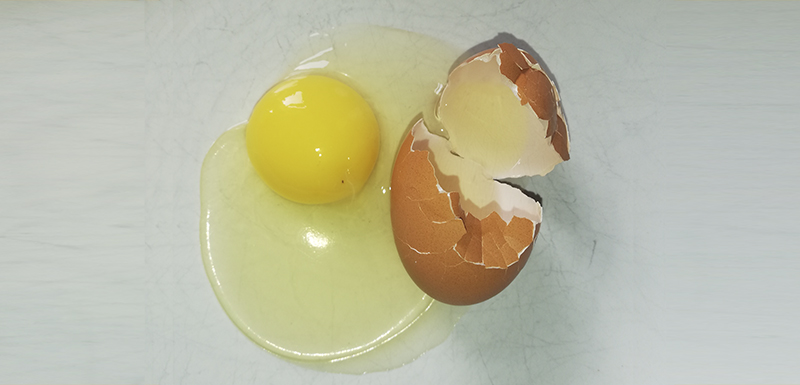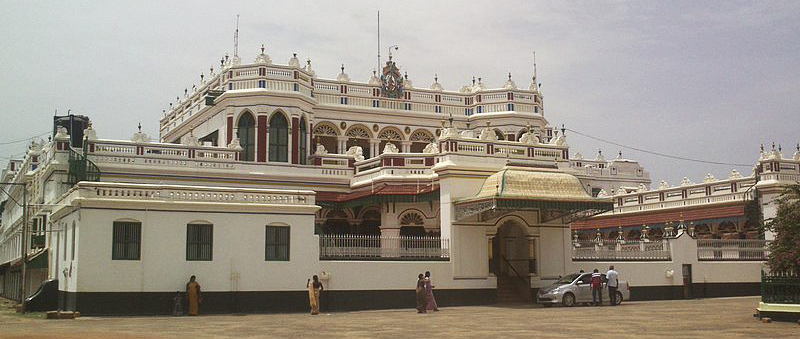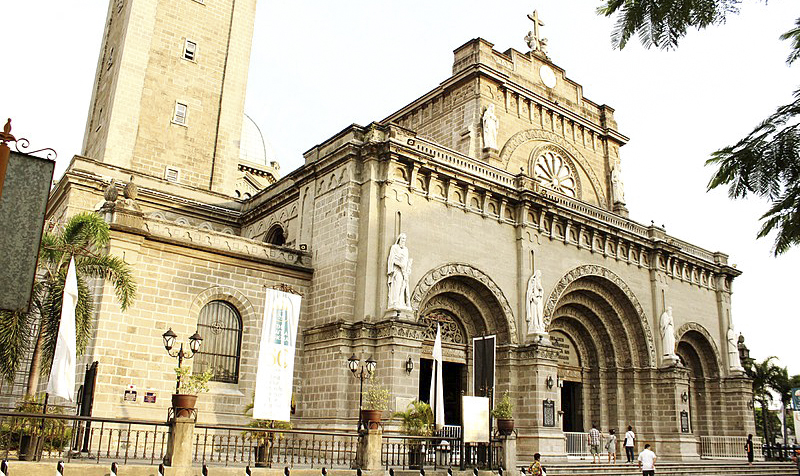Eggcellent finishes
Contents |
[edit] The use of eggs in traditional and contemporary construction finishes
Whilst eggs are not normally thought of as a construction material there are a number of cases where parts of eggs have been used both in traditional and contemporary construction.
The eggshell is made primarily from calcium carbonate, which is also the chemical compound that makes up the majority of chalk and limestone, as well as sea shells, which in turn are used to create slaked lime or hydraulic lime used in construction. Proteins order the nanoparticles of calcium carbonate crystals, forming the calcite mineral which is the shell, which has thousands of tiny pores, to allow gases to pass in and out.
The contents of an egg is normally the equivalent to around 3 tablespoons, one of which is made up of the yolk and two the egg white. The main chemical components of a hens egg are 12% lipids, 12% proteins, and water along with small amounts of carbohydrates and minerals. When whisked they make a foam substance which physically unravels the proteins, making them 'line up'. The hydrophilic ends of the proteins attract to water and the hydrophobic ends attract air, creating pockets; the protein coating the air pockets links together, making a foam. These properties, bear some relation to rare but interesting construction methods.
[edit] Chettinad egg plaster
Chettinad plaster is a traditional technique of lime plastering that originates from Chettinad, Tamil Nadu in Southern India. It can be found on many of the mansions in the area built around the 1700's by the wealthy trading community known as Nattukottai Chettiars, and is notable for its particularly smooth light finish. It is created by using a specific local traditional plastering technique known as Chettinad egg plaster, a gradual process of applying 6 different thin layers of plaster with the first with sand and the last with the addition of egg white. (Image credit: The Chettinad palace karaikudi. Author User: Karthick jack under a Creative Commons license)
- Base coat. The first layer or base coat of this plastering technique contains limestone, which is a hydraulic lime crushed and powdered. This is mixed with sand and water to create a binding layer which is then applied to the existing wall to bond the new plaster.
- Subsequent layers. Four further layers are applied which are made from a mixture of shell lime (which is made traditional), mixed with local Kalmavu white stone which is ground to a fine powder. The shell lime is made according to traditional hand methods - the limestone or sea shells (conches) are burned at high temperature, then water is added, which is known as slaking the lime. The sea shells are effectively calcium carbonate, which when heated up expels carbon dioxide and becomes calcium oxide. When water is added the hot mixture steams and cools releasing heat to create a crumbling mixture, which when dry is a white powder, calcium hydroxide, lime plaster. The plaster is gradually applied thinner and thinner with each coat at this stage until ready for the final coat.
- Final coat. In the final layer the same mixture is created as before, but at this stage egg white is added to the mixture. First the egg white is agitated to create a soapy foam, and is then added to the lime plaster mixture. The egg white helps lighten the mix making it soft and helping to reduce shrinkage and potential future cracking. At this stage milk whey is also added, this is the liquid remaining once the more solid milk curd is squeezed. As with any activated lime plaster the inactive original material is converted to a chemically active material during application and over time returns back to being an inactive material. As the mixed and applied lime plaster on the wall stays in contact with the air, it re-absorbs carbon dioxide and over a longer period gradually returns to being a relatively hard calcium carbonate as it was in the form of the original stone and shells. During the final mixing stage pigments may also be added and in some cases also vajjram (tallow).
The final stage might also involve rubbing the surface with stone to help create the fine smooth finish, closing or sealing the surface which then requires no further treatment.
[edit] Argamasa egg mortar
Argamasa mortar (also as a render) is the name given to an element of the exterior finish of many of the churches found in the Philippines. It is notable because of the novel technique of adding egg white to the mortar mixture, which in turn led to the creation of a local delicacy called San Nicolas cookies from the remaining egg yolks. (The Manila Cathedral -Church of Manila. 25 April 2018. AuthorJabrian37 under a Creative Commons license)
Examples of argamasa mortars can be found in the Philippines from the period of the Spanish occupation, where egg-whites were used as emulsifiers for mortars (and some renders) by various religious orders, right through from the Augustinians and Franciscans to Jesuits. The Spanish colonial era lasted from the mid 1500's to the end of the 1800's and the Philippines was an important trading centre for the Spanish empire and many stone churches were built to mark both the Spanish presence and religious beliefs.
A culinary historian from the Philippines Pia Lim-Castillo noted “Taking into account all the churches built then, the number of eggs used ran into the millions.” As a culinary expert she also noted that it was after the Spanish had arrived that a local delicacy, which still exists today, (long after the concrete replaced these materials) called San Nicolas cookies were made, most probably because of the remaining egg yolks left from the construction of the churches. “The extensive use of egg white and eggshells brought about the ingenuity of the Filipino women who saw all these egg yolks being thrown in the river,” writes Pia Lim-Castillo. “Recipes were created to make use of the egg yolks, like pan de San Nicolas, yema, tocino del cielo, leche flan, pastries, and tortas.”.. “the number of eggs used ran into the millions.” (Eggs in Cookery, proceedings of the Oxford symposium on food and cookery edited by Richard Hoskin Prospect Books 2007)
A Spanish Dominican historian Fr. Pablo Fernandez OP, author of History of the Church in the Philippines, further confirms that the use of stone and masonry construction in the country can be attributed to the Jesuit missionary Antonio Sedeño, who history shows was said to have “knowledge of quarrying [and] finishing stone, erecting arches, and measuring distances. [His] work was copied by others and carried throughout the archipelago.” Dr. Michelle Sotaridona Eusebio, from the Department of Anthropology, University of Florida, supported the claim that that eggs were combined with lime, sand, water, and various ingredients to make the mix.
Pampanga churches such as the Holy Rosary Parish Church in Angeles City, San Guillermo Church in Bacolor, St. Augustine Church in Lubao, and St. James the Apostle Church in Guagua, are examples of churches which contained eggs. Manila Cathedral in Intramuros, Manila, used duck eggs as shown by the expenses list for the mortar made by Friar Mariano Gomes of Cavite, in 1824. Highlighted in the paper 'Eggs in Philippines Church Architecture and its Cuisine', by Pia Lim-Castillo higlights "records show that the dome of the Manila Cathedral was sealed in 1780 with a layer of lime, powdered brick, duck eggs, and bamboo sap."
A similar technique, used internally can be found in Chettinad, Tamil Nadu in Southern India, with the use of Chettinad egg plaster, a traditional technique of lime plastering that can be found on many of the mansions in the area built around the 1700's by the wealthy trading community known as Nattukottai Chettiars.
[edit] Egg-shell concrete
Egg-shell concrete involves the use of crushed eggshell powder as a supplementary cement material (SCM) helping to improve strength and or reduce the amount of ordinary Portland cement required.
The history of supplementary cementing materials in construction originated with the ancient Greeks who used volcanic ash and hydraulic lime to create cement mortars, and then the Romans created what we know call Roman concrete. Supplementary cementing materials (SCMs) are materials that when used with Portland cement can contribute to the properties of hardened concrete through hydraulic or pozzolanic activity or both. Most commonly fly ash, ground granulated blast furnace slag (GGBFS) and silica fume are used, but some research has been carried out on the use of other waste products including egg-shells as well as saw dust ash, rice husk ash, and sugarcane bagasse ash.
The Magazine of Concrete Research refers to eggshell as a partial cement replacement in concrete development (Yeong Yu Tan Shu Ing Doh Siew Choo Chin) "Research on the reuse of waste materials in the concrete industry has been quite intensive in the past decade. The objective of this research is to identify the performance of oven-dried eggshell powder as a partial cement replacement in the production of concrete under both water-cured and air-cured regimes. Eggshell powder of various amounts, namely 5%, 10%, 15% and 20% by volume, was added as a replacement for ordinary Portland cement."
"The results showed that water-cured eggshell concrete greatly improved the compressive and flexural strength of concrete, by up to 51·1% and 57·8%, respectively. The rate of water absorption of eggshell concrete was reduced by approximately 50%, as eggshell powder filled up the existing voids, making it more impermeable. However, the compressive strength of the eggshell concrete decreases gradually when the amount of eggshell powder increased, during immersion in acid and alkali solutions, because eggshell contains a high amount of calcium, which reacts readily with acid and alkali solutions."
"As the eggshell content increases, the solution reacts with the paste so the bonding of the paste reduces, and therefore the strength also reduces. The reduction of compressive strength during immersion in sulphuric solution and sodium sulphate solution was 27·5% and 31·2%, respectively, when 20% eggshell powder was used to replace cement. It can be concluded that the optimum percentage of oven-dried eggshell powder as a partial cement replacement is 15%."
[edit] Eggshell paint
Eggshell is used as a paint finish, and egg references are also used to describe colours that resemble different parts or type of eggs, but is unlikely today that these paints actually contain any egg ingredients.
Eggshell finish paints were introduced in the mid-1970s to offer a more durable finish for residential and rented apartments. This paint, with less sheen, is a somewhat satin type of finish bur softer and not as shiny as semigloss. Still durable, it can be cleaned more easily than standard paint finishes.
Colour names relating to eggs are also sometimes also used to categorise paints such as egg shell white, duck egg white, egg yolk yellow or eggshell blue, although again these are unlikely to contain actual egg ingredients.
However tempera, also known as egg tempera, is a permanent, fast-drying painting medium which consists of coloured pigments mixed with a water-soluble binder medium, usually a glutinous material such as egg yolk. Studies of old masters have also detected trace quantities of protein residue in oil paint, though previously thought of as contamination it is today thought that this shows painters such as Leonardo da Vinci, Botticelli and Rembrandt would have used proteins with the paint, most probably from egg yolk. Egg yolk is still sometimes used by contemporary artists.
[edit] Related articles on Designing Buildings
- Cement mortar.
- Concrete.
- Finishes.
- Lime mortar.
- Lime plaster.
- Mortar.
- Paint.
- Plaster.
- Polished plaster.
- Stucco.
[edit] External links
- https://www.youtube.com/watch?v=Q69uLjnVxEE
- https://www.youtube.com/watch?v=36AVxjgD290
- https://www.chidambaravilas.com/blog/chettinad-plaster/
- Eggs in Cookery, proceedings of the Oxford symposium on food and cookery edited by Richard Hoskin Prospect Books 2007
- Eggs in Philippines Church Architecture and its Cuisine by Pia Lim-Castillo
- Eggs in Cookery, proceedings of the Oxford symposium on food and cookery edited by Richard Hoskin Prospect Books 2007
- https://www.esquiremag.ph/culture/lifestyle/churches-philippines-built-with-eggs-a2765-20220614-lfrm
- https://www.atlasobscura.com/articles/filipino-desserts
- Characterization and Assessment of Argamasa Applied as a Water-Resistant Masonry Surface Finish on the Dome of the Capilla de Nuestra Seora del Rosario Iglesia San Jos, San Juan, Puerto Rico Jill T. Verhosek. Uni Pennsylvania.
Featured articles and news
British Architectural Sculpture 1851-1951
A rich heritage of decorative and figurative sculpture. Book review.
A programme to tackle the lack of diversity.
Independent Building Control review panel
Five members of the newly established, Grenfell Tower Inquiry recommended, panel appointed.
Welsh Recharging Electrical Skills Charter progresses
ECA progressing on the ‘asks’ of the Recharging Electrical Skills Charter at the Senedd in Wales.
A brief history from 1890s to 2020s.
CIOB and CORBON combine forces
To elevate professional standards in Nigeria’s construction industry.
Amendment to the GB Energy Bill welcomed by ECA
Move prevents nationally-owned energy company from investing in solar panels produced by modern slavery.
Gregor Harvie argues that AI is state-sanctioned theft of IP.
Heat pumps, vehicle chargers and heating appliances must be sold with smart functionality.
Experimental AI housing target help for councils
Experimental AI could help councils meet housing targets by digitising records.
New-style degrees set for reformed ARB accreditation
Following the ARB Tomorrow's Architects competency outcomes for Architects.
BSRIA Occupant Wellbeing survey BOW
Occupant satisfaction and wellbeing tool inc. physical environment, indoor facilities, functionality and accessibility.
Preserving, waterproofing and decorating buildings.























Comments
[edit] To make a comment about this article, click 'Add a comment' above. Separate your comments from any existing comments by inserting a horizontal line.